Career Service Center
A nationwide platform preparing students in Nepal for real-world careers.

Industry
EdTech | Career Services | Workforce Development
Role
UI/UX Designer
Team
Collaborated with the product owner, project manager, front-end back-end engineers, and QA
Duration
8 months
Approach
User-centered design
Tools
Figma, Figjam, Slack, Miro
Overview
Career Service Center (CSC) is a digital platform developed to close the gap between academic learning and real-world job readiness in Nepal. It combines self-assessment tools, job-role-specific training, and direct access to internships and employment opportunities offering a unified experience for students, employers, and educational institutions.
Problem Space
Graduates in Nepal frequently leave university without the skills needed for real-world jobs, while employers face difficulty finding job-ready talent. Existing solutions are fragmented and fail to provide a unified, accessible platform for skill-building, self-assessment, and job placement tailored to local needs. CSC was created to solve this disconnect by offering a centralized, job-readiness platform tailored to the local context.
My Role
As the Lead UX/UI Designer, I managed the entire design process from research to delivery, collaborating closely with product managers, developers, educators, and partners to define requirements and priorities. I conducted user research and usability testing to uncover pain points and validate designs, creating modular workflows and high-fidelity interfaces that met both user needs and business goals. I also developed reusable UI components to ensure design consistency and worked closely with engineering and QA teams to guarantee smooth handoffs and high-quality implementation.
Problem Statement
How might we effectively bridge the gap between academic skills and industry requirements to better prepare students for employment?
User Research & Key Insights
User research for the Career Service Center involved understanding the needs of students and employers through surveys, interviews, and feedback from training sessions. These insights guided the design of key features focused on skill development, self-assessment, and job matching. By continuously iterating based on user feedback, we ensured the platform remained intuitive, relevant, and aligned with the evolving needs of its users.
Survey
We conducted surveys and interviews with 55 potential users to gain insights into their experiences, expectations, and challenges related to career development. The target audience, ranging from ages 20 to 50, included university students, recent graduates, and early-career professionals. This research provided a mix of quantitative and qualitative data that directly informed the design decisions and feature development of the Career Service Center platform.
72%
Unclear Skill Direction
72% of users reported being unsure about which skills to prioritize, pointing to the need for guided learning paths and role-specific recommendations.
65%
Soft Skills Gap
65% of participants lacked confidence in soft skills such as communication and professionalism, signaling the importance of dedicated soft skill training.
58%
Difficulty Finding Opportunities
58% struggled to connect with relevant job or internship opportunities, highlighting the need for a built-in job matching system.
Interview
Following the analysis of initial survey data, we conducted in-depth interviews with a focused group of 15 participants, including students, recent graduates, and early-career professionals. These sessions were held via Zoom at flexible times to accommodate participants’ schedules. The goal was to gain deeper insights into their career development challenges, expectations from the platform, and specific pain points in navigating skill-building and job opportunities.

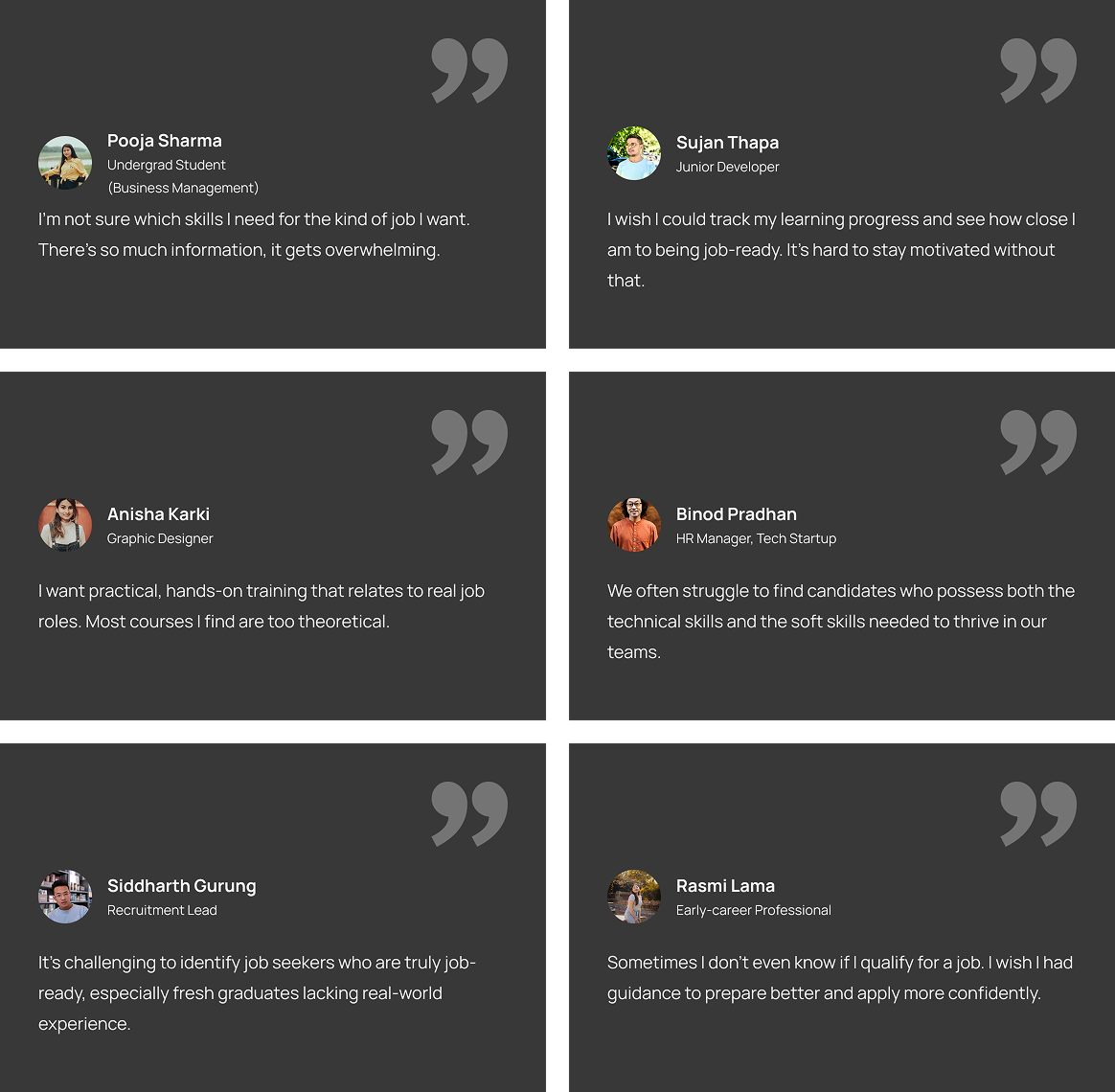
User Persona
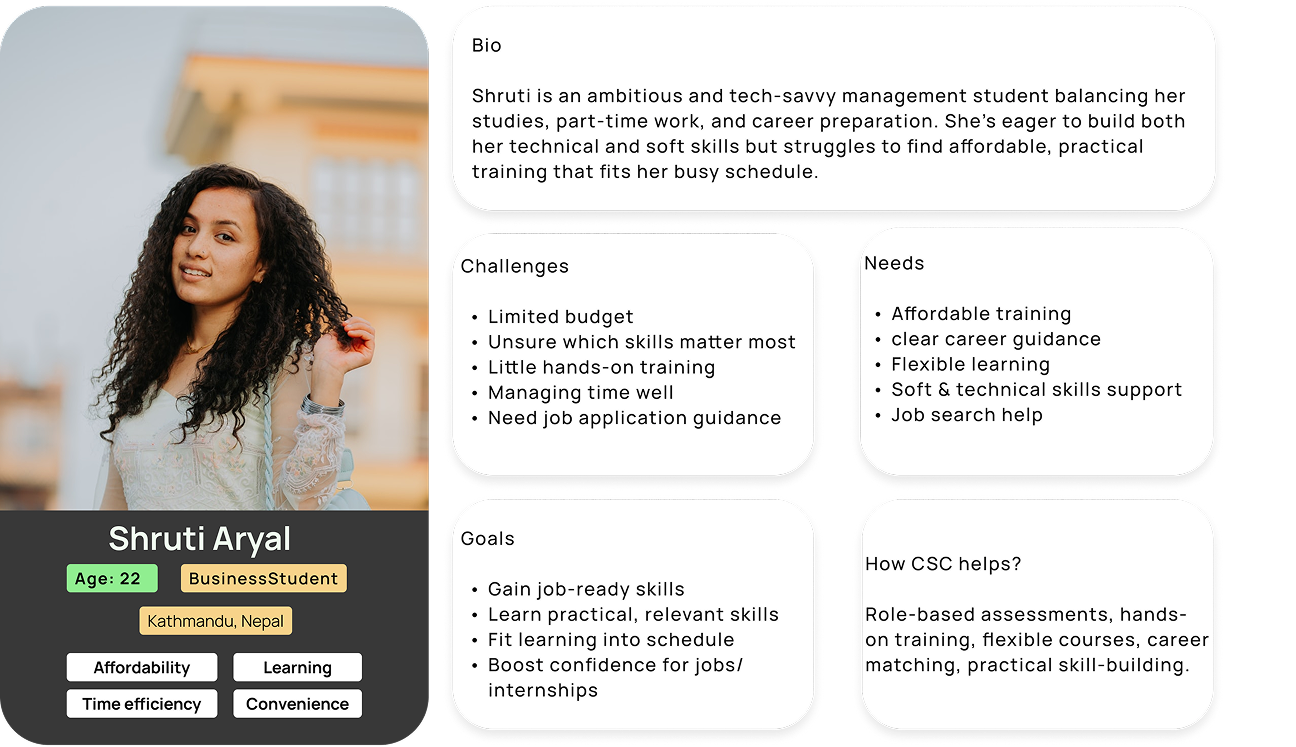
User Journey Map

Design Goals
Based on user research, interviews, and survey insights, we defined clear design goals to directly address the most pressing challenges faced by students and employers. These goals guided every design decision to ensure the platform was user-centric, relevant, and scalable.
- Simplify Skill Discovery: Help users understand which skills are essential for their desired roles through guided assessments and recommendations.
- Support Self-Paced Learning : Offer flexible, modular content that fits into users' busy schedules and allows for measurable progress tracking.
- Bridge the Gap Between Learning and Employment : Create a seamless experience from skill-building to real-world opportunities by integrating job-role-specific training with internship and job access.
- Personalize the Learning Journey : Tailor the dashboard and course recommendations based on user goals, assessment results, and progress.
- Empower Through Clarity and Confidence : Ensure users always know where they stand and what to do next with actionable insights and intuitive design patterns.
Design Process
Proposed Features
After thoroughly analyzing user research and feedback, we identified key design goals to directly tackle the challenges students and employers face in bridging the academic-industry gap. These goals guided us in developing focused features for Career Service Center, ensuring an engaging, user-friendly platform that effectively supports skill development, self-assessment, and job matching to better prepare students for the workforce.
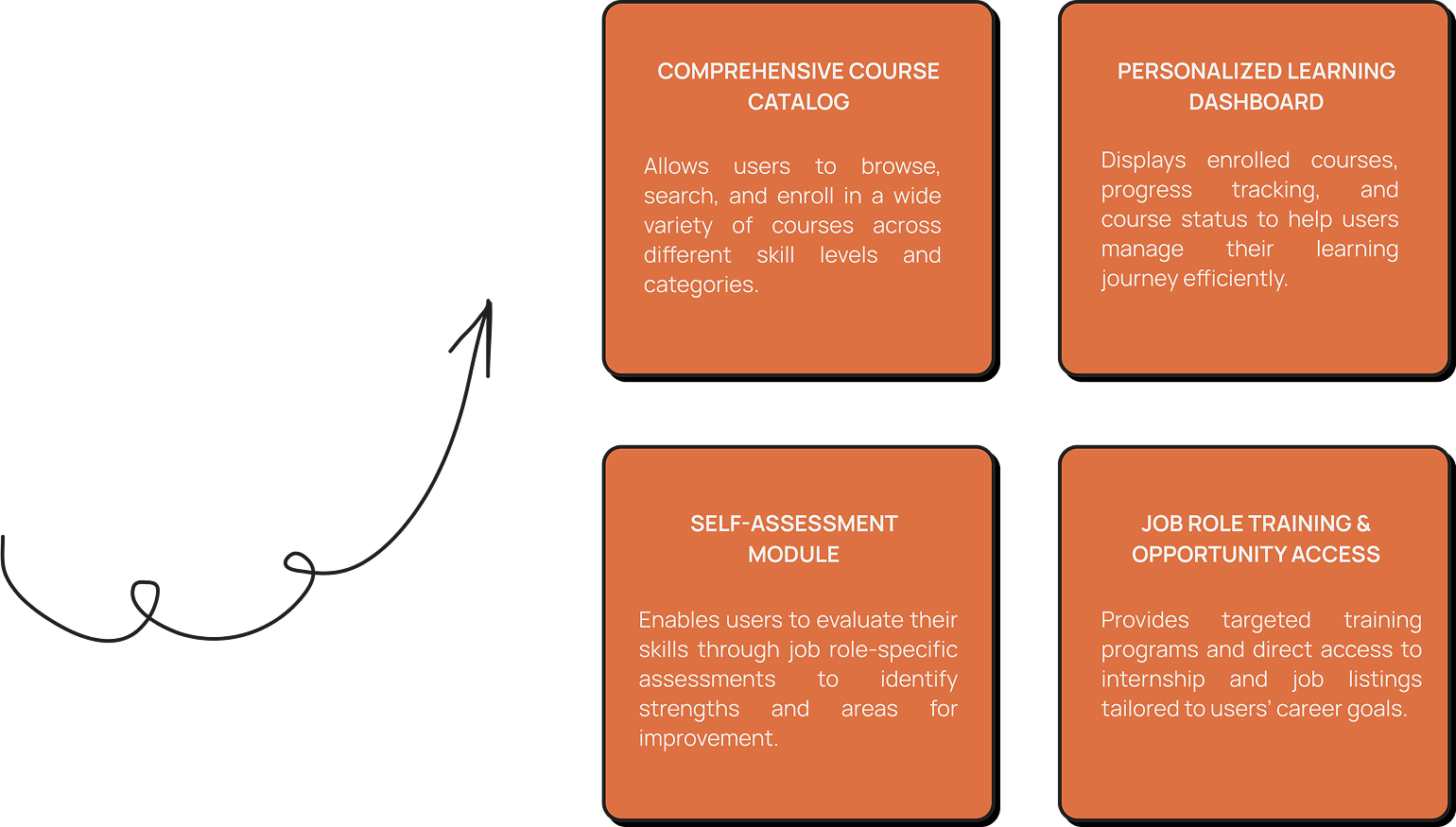
User Flow
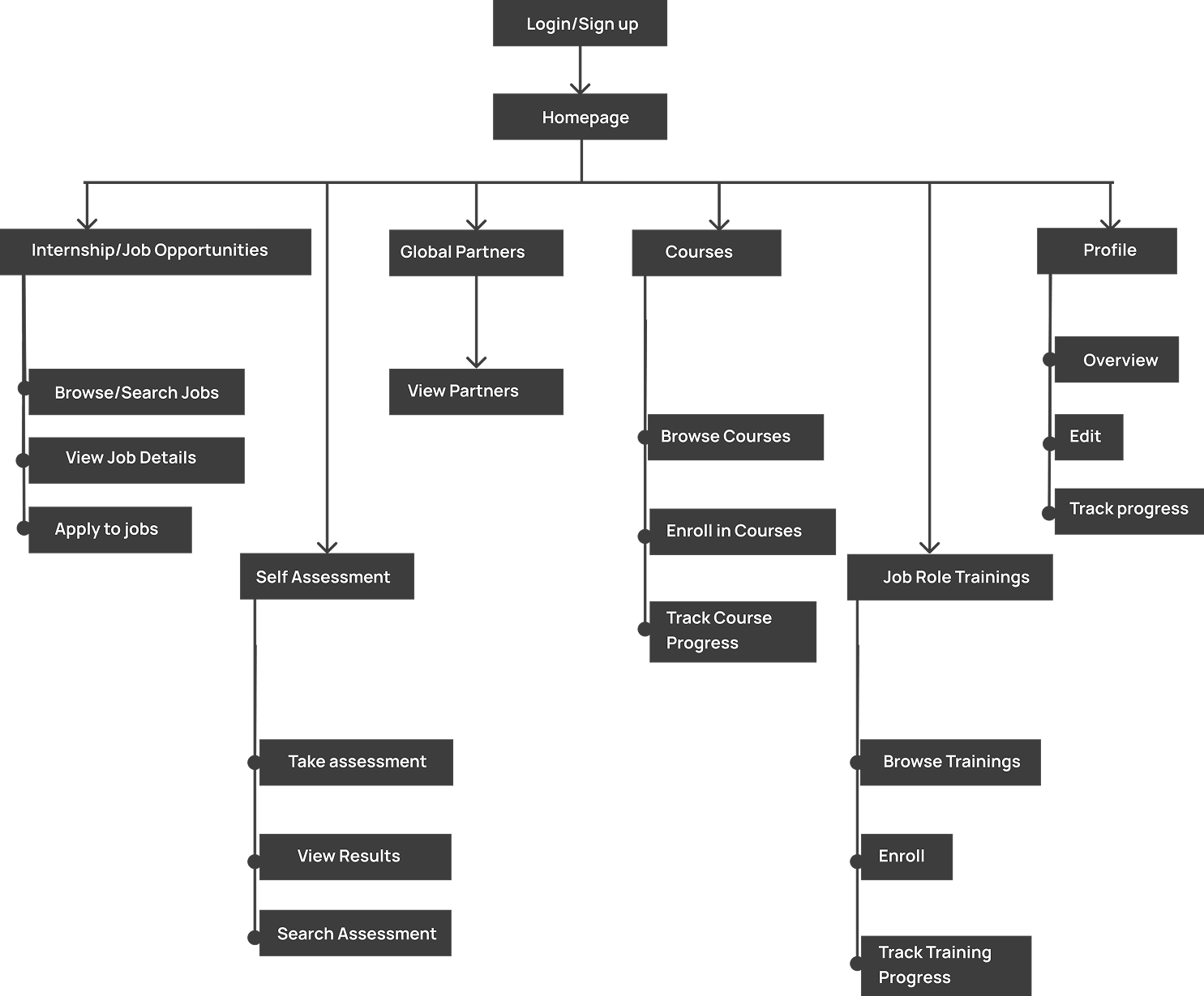
Typography and Colors
Font Family: Inter

Final Design
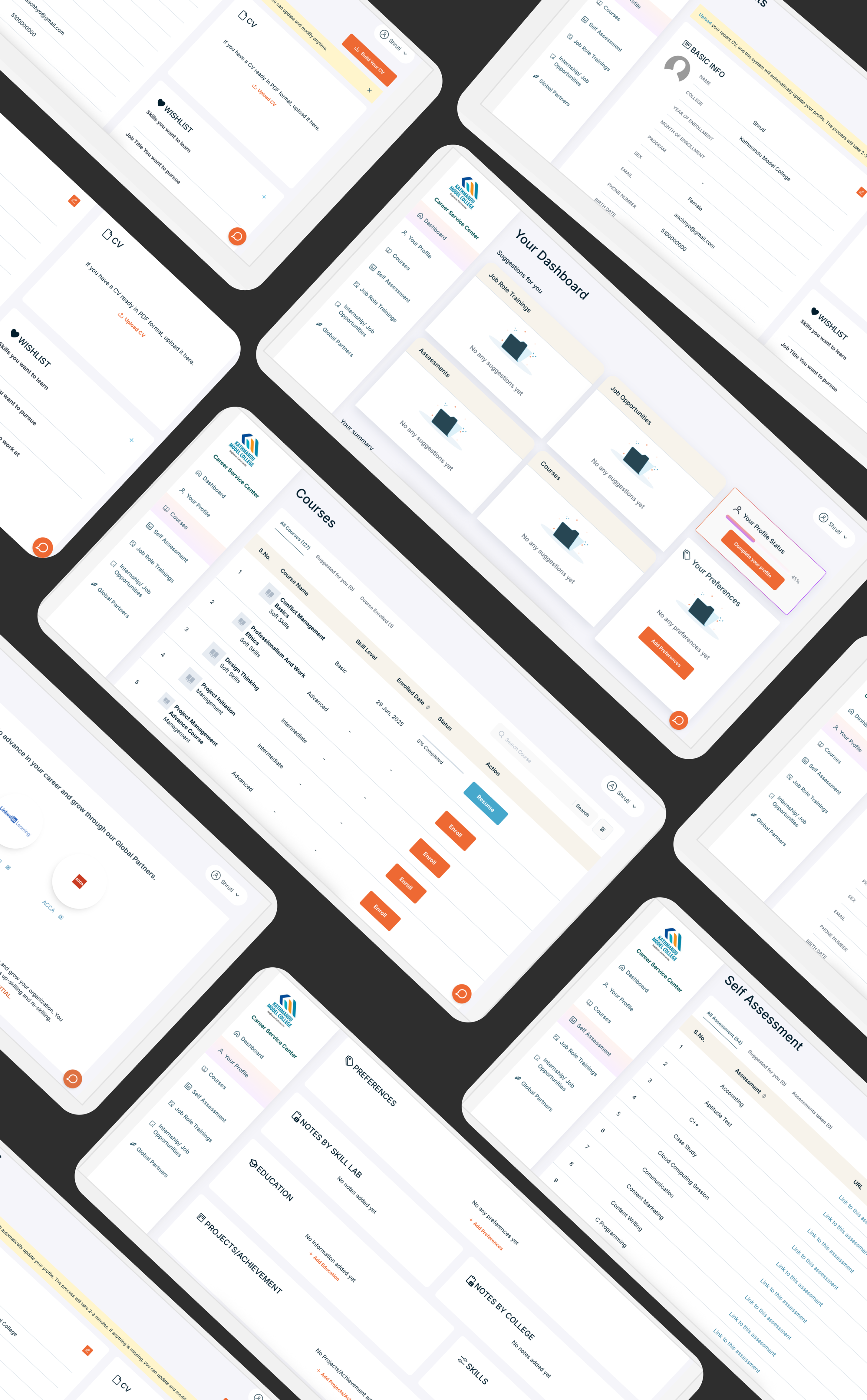
Outcomes & Impact
1000+
Schools Adopted
The platform was used by over 1,000 schools and colleges across 77 districts, showing wide national adoption.
80+
New Partners Onboarded
80+ institutional partners joined in 6 months, expanding platform reach and credibility.
10+
Modules Delivered
The company delivered diverse training content, increasing platform stickiness and long-term user retention.
60%
Fewer Revisions
Development teams saved time with fewer design errors, improving product stability and launch speed.
See it Live
Visit the Career Service Center: careerservicelab
(Note: This is the live deployed version post-development handoff. The platform is customized and used by different colleges and schools, each featuring their own name and logo within the interface.)
Reflection
Working on CSC gave me the opportunity to design for real social impact. I learned how to navigate government and educational constraints, balance local accessibility needs, and create scalable systems used at a national level. If I could revisit this project, I would incorporate gamification in skill progression and explore SMS-based notifications for users in low-connectivity areas.